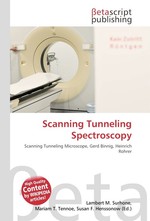Scanning Tunneling Spectroscopy
Lambert M. Surhone, Mariam T. Tennoe, Susan F. Henssonow
бумажная книга
High Quality Content by WIKIPEDIA articles! Scanning tunneling spectroscopy (STS) is an experimental technique which uses a scanning tunneling microscope (STM) to probe the local density of electronic states (LDOS) and band gap of surfaces and materials on surfaces at the atomic scale. Generally, STS involves observation of changes in constant-current topographs with tip-sample bias, local measurement of the tunneling current versus tip-sample bias (I-V) curve, measurement of the tunneling conductance, dI / dV, or more than one of these. Since the tunneling current in a scanning tunneling microscope only flows in a region with diameter ~5A, STS is unusual in comparison with other surface spectroscopy techniques, which average over a larger surface region. The origins of STS are found in some of the earliest STM work of Gerd Binnig and Heinrich Rohrer, in which they observed changes in the appearance of some atoms in the (7 x 7) unit cell of the Si(111) – (7 x 7) surface with tip-sample bias.
Данное издание не является оригинальным. Книга печатается по технологии принт-он-деманд после получения заказа.


